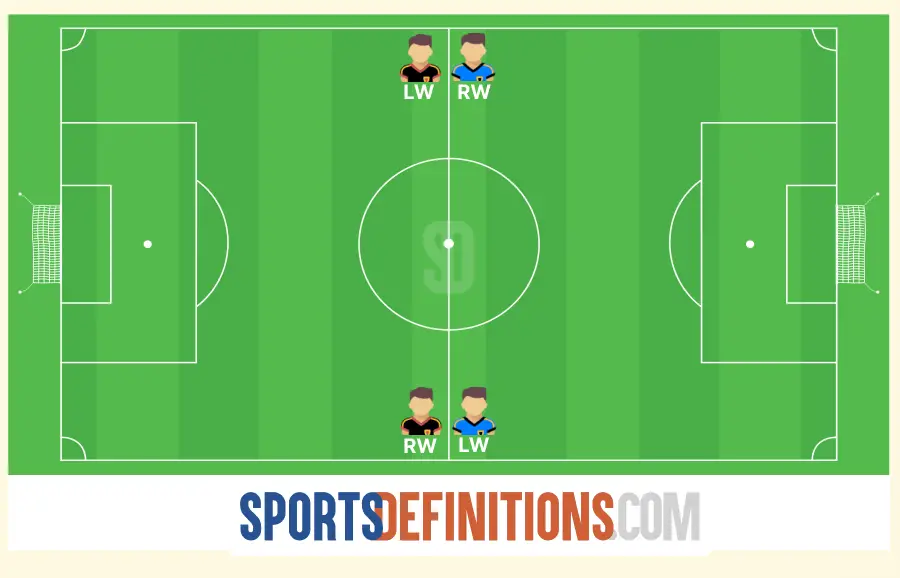Winger
A winger is the widest attacking player in the team, staying out on either side of the pitch with the intention of dragging the opposing defenders wide, creating space for their teammates.
Wingers are usually the fastest players on the pitch as speed is important for this position. Strength, stamina, and the ability to dribble are also crucial to a winger.
How many wingers are there and where are they positioned?
A Soccer team will almost always set up with two wingers for every match, sometimes depending on the formation. However, most formations use and need wingers to be effective.
The two wingers are positioned on either touchline, one on the right and one left of the pitch. Depending on the formation used they form part of the midfield, usually in a 4-4-2, playing in front of the fullback. If the team decides to play in a 4-3-3 formation then the winger becomes more of an attacker, playing alongside the striker.
Their primary role is to stay in these wide positions, however, in modern-day soccer, it is common for the wingers to switch sides of the pitch to disrupt and opposition defense or from a tactical change by the coach.

Roles of a Winger in soccer
A winger is part of the main attack in the starting team, so it has many important attacking roles in a soccer match. These include:
- Taking on opposition players – using speed and skill to get past the opposition players. This can be most important when their team is on a counter-attack as the opposition defense may not be organized. Once a winger has successfully got past the opponents they should then be in a position to find a teammate in an attacking position.
- Providing crosses into the opposition penalty area – putting the ball into the perfect area while giving teammates an opportunity to score. A winger will try to stay tight to their touchline throughout the match, however, once a teammate has passed them the ball they will try to come central from their wing and get the ball into the penalty area. The forwards of the team should be in and around the opposition goal area so the quality of pass must be perfect.
- Attacking crosses from the opposite wing – being ready to try and receive a fellow teammate’s cross. Although the primary role of a winger is to assist the forwards it is also important they try to find space in the box to attack crosses that are delivered from the opposite wing. It is often the case that wingers can drift in from their wing unnoticed by the opposition defense.
- Create space for teammates – using the width of the pitch to create space for their teammates, in our around the opposition penalty area. Throughout a match, wingers will try to keep the ball close to their touchline, pulling the opposition fullback out wide. This usually creates space for other midfielders and attackers to run into.
- Score goals – helping the team by scoring goals from wide positions or set pieces. As it’s now common for wingers to be part of an attack, scoring goals is an important part of their game. Forward players nowadays are expected to interchange and play all positions in attack. Goals can be scored from distance, dribbling the ball into the penalty area and past the goalkeeper, or linking up play with a one-two pass with a teammate.
However, for many coaches, the modern-day winger is also expected to track back and help with the defensive side of a match, including from opposition set-pieces and counter-attacks.
In modern-day soccer, teams defend as a unit so all 11 players are required to help out defensively. A winger is required to track back and tackle an opponent, usually the opposition fullback or winger. This is usually the case when a winger loses the ball in an attacking situation.
Defending set-pieces such as corners are also a team responsibility so a winger must be ready to help their team whether their team uses man-to-man marking or a zone defense.
Is there a particular formation that wingers play in Soccer?
Nowadays in soccer, a winger can be expected to play in many formations depending on the opposition team. Formations can also change throughout a match depending on whether an offensive or defensive style of play is being used.
The most common formations where wingers are particularly needed are the classic 4-4-2 and 4-3-3.
What is the difference between a winger and a forward in Soccer?
In modern-day soccer there isn’t much difference between these two positions on the pitch, the biggest difference being their position and role. There is also the striker position that forms an offensive line but has a different position and role.
Firstly, a winger’s main position is to play wide and close to the touchline with the primary role of assisting and providing for the other attacking players.
Forwards are players that can play in any of the attacking positions, whilst scoring goals for the team. These players have the attributes to play as a striker but are not usually classed as strikers.
A striker is a player who plays closest to the opposition goal and has the primary role of scoring the majority of their team’s goals.
